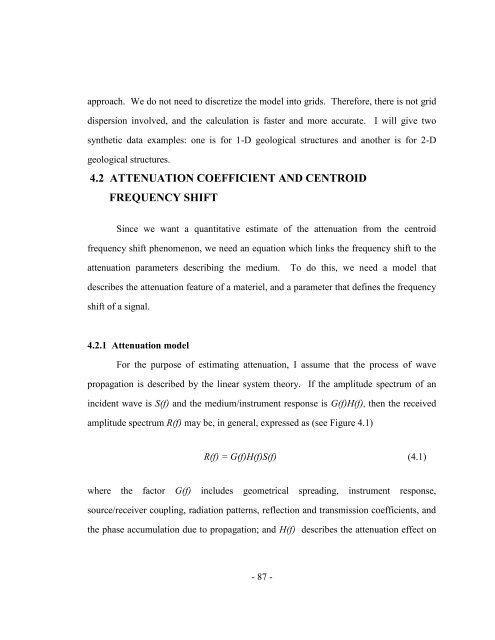My PhD Thesis, PDF 3MB - Stanford University
My PhD Thesis, PDF 3MB - Stanford University
My PhD Thesis, PDF 3MB - Stanford University
Create successful ePaper yourself
Turn your PDF publications into a flip-book with our unique Google optimized e-Paper software.
approach. We do not need to discretize the model into grids. Therefore, there is not grid<br />
dispersion involved, and the calculation is faster and more accurate. I will give two<br />
synthetic data examples: one is for 1-D geological structures and another is for 2-D<br />
geological structures.<br />
4.2 ATTENUATION COEFFICIENT AND CENTROID<br />
FREQUENCY SHIFT<br />
Since we want a quantitative estimate of the attenuation from the centroid<br />
frequency shift phenomenon, we need an equation which links the frequency shift to the<br />
attenuation parameters describing the medium. To do this, we need a model that<br />
describes the attenuation feature of a materiel, and a parameter that defines the frequency<br />
shift of a signal.<br />
4.2.1 Attenuation model<br />
For the purpose of estimating attenuation, I assume that the process of wave<br />
propagation is described by the linear system theory. If the amplitude spectrum of an<br />
incident wave is S(f) and the medium/instrument response is G(f)H(f), then the received<br />
amplitude spectrum R(f) may be, in general, expressed as (see Figure 4.1)<br />
R(f) = G(f)H(f)S(f) (4.1)<br />
where the factor G(f) includes geometrical spreading, instrument response,<br />
source/receiver coupling, radiation patterns, reflection and transmission coefficients, and<br />
the phase accumulation due to propagation; and H(f) describes the attenuation effect on<br />
- 87 -
















